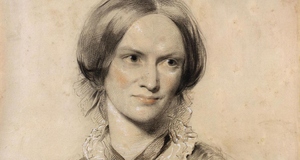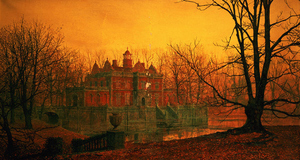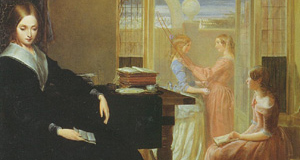Gothic Romance in The Haunting of Bly Manor: The Modern Transformation of the Victorian Gothic
By
2022, Vol. 14 No. 02 | pg. 1/1
IN THIS ARTICLE
KEYWORDS
AbstractThis article explores the expression of the Gothic romance genre in the 21st century, by examining Mike Flannagan’s The Haunting of Bly Manor. Very little literature focuses on contemporary expressions of this genre. The Gothic reflects the social, cultural, and political anxieties of society, and these naturally differ between works depending on the time they were written. Due to emancipation, the conventional central problem of the Gothic Romance – love as the main obstacle – is no longer feasible in our contemporary society. Furthermore, many of the repressed themes often explored through Gothic elements are no longer considered taboo in the present day. Instead, traumatic matters are thoroughly examined, such as in The Haunting of Bly Manor. This show contains all the typical ingredients for a gothic romance, but its formula has been altered. In The Haunting, the Gothic forms the backdrop of the story and the love – with all its traditionally taboo elements – is presented at the front, out in the light. Additionally, the love story is not the central problem of the narrative, but rather the solution to the plot’s main obstacle. Thus, Flannagan gives the Gothic Romance a modern spin and subverts the genre. This paper focuses on the genre of Gothic romance, and how this genre has evolved into the 21st century. By examining Mike Flannagan’s 2020 tv-show The Haunting of Bly Manor, I will argue that this tv-show subverts the genre of Gothic romance. The Haunting of Bly Manor is a modern adaptation of Henry James’ The Turn of the Screw. It also includes some of James’ other short stories, such as ‘The Romance of Certain Old Clothes’ and ‘The Jolly Corner’. The Haunting of Bly contains all the typical ingredients for a gothic romance – a young governess, a large, haunted manor, two beautiful but slightly peculiar children, and ghosts – but its message concerning love diverges from older specimen. The Gothic helps articulate the social, cultural, and political anxieties of society, and these naturally differ between works depending on the time they were written (Schmitt, 2007). With emancipation and the emergence of women’s rights, the conventional central problem of the (Victorian) Gothic Romance – love as the main hardship in the narrative – is no longer feasible in our 21st century society. Consequently, in The Haunting of Bly, the love story is not the central problem of the narrative – as it is in many gothic romances like Jane Eyre – but rather the solution to plot’s main obstacle. Furthermore, the romance in The Haunting of Bly Manor is a queer romance. With his adaptation of The Turn of the Screw, Flannagan gives the Gothic Romance a modern spin and subverts the genre of Gothic Romance. This is more fitting to a 21st century Gothic Romance, as opposed to the (classic) Victorian Gothic romance. The Victorian Gothic RomanceThe origin of the Gothic romance dates back to the publication of Horace’s Walpole The Castle of Otranto. This novel established some of the most well-known conventions of the genre, such as ancient castles, family secrets, ghosts and apparitions, or hidden identities (Fuchs, 2004). Gothic romances often include stories about naive women and the dangerous, wealthy men who lure them. It carries elements such as an old castle or manor, an atmosphere of suspense, supernatural events, high emotions, and women in distress. The main plot concerns two people falling in love and struggling to make the relationship work. This romance is often the main obstacle in the story (Fuchs, 2004). In literature, the gothic provides the means to reflect not only aspects of the social and political world but also what was deemed as previously hidden or elusive matters, such as psychological interiority or sexual deviance; something which was especially prevalent in the rigid Victorian age. (Schmitt, 2007, p. 305). One of the most famous novels that can be qualified as a Gothic Romance is Charlotte Brontë’s Jane Eyre (1848).The Gothic romance often dealt with longing and repressed desire, as also evident in Jane Eyre. Because of Jane’s social status as a governess and her position as a woman, she cannot overtly act on her desires for her employer Mr. Rochester. These desires are thus expressed through the gothic, which in Jane Eyre can be recognized in Bertha, who externalizes the feelings that Jane and Mr. Rochester keep within (Schmitt, 2007). Furthermore, the Victorian Gothic is concerned with the past – itself originating from an antiquated era – yet it remains, ‘haunting’ later literary novels and forms (Schmitt, 2007, p. 306). So, gothic romance in the Victorian period was often to speak of something that should have disappeared but nonetheless remains and returns. Some of the feminist or Marxist readings of the Gothic romance novel are overwhelmingly negative (Fuchs, 2004). These readings point out that the heroine in many of these stories, in order to achieve her happy ending, has to sacrifice her independence and concede to the customs of patriarchal society (Fuchs, 2004). It seems then that for the woman in these stories, there is hardly a way to achieve the desired outcome. The love in the Victorian romance provided women with the ultimate source of trial, as they were confronted with issues of sex, class, and repressed yearning. In the 21st century, the odds of achieving such a desired end are be a lot better. Arguably, such a love would barely provide a source of tribulation at all for women in contemporary society, as the emergence of women’s rights have greatly changed the landscape in which these romances have to be navigated. Does the Victorian Gothic romance then still hold a place in our contemporary society? Is there still any merit in their creation? In his Gothic Literature (2013), Smith discusses the Neo-Victorian romance. Neo-Victorian stories imaginatively recreate the Victorian novel, often in self-reflexive ways that provide an insight into the, often hidden, themes (such as tabooed sexuality), which are implicit in Victorian novels. Such Neo-Victorian novels thus represent a resurrection of the past because they often include (Victorian) apparitions or ghosts which gives rise to a form of the uncanny (Smith, 2007, p. 170). However, this is paralleled with an engagement with the present because, “Neo-Victorianism also tries to understand the 19th century as the contemporary self’s uncanny Doppelganger, exploring the uncertain limits between what is vanished (dead) and surviving (still living), as such novels address the continuing presence of issues about race, gender, and class inequalities” (Smith, 2007, p. 170-171). The Haunting of Bly Manor also includes Neo-Victorian aspects, as it based on a Victorian novel, and it maintains many of its typical elements, while at the same time focusing on more present-day issues, such as sexual orientation. The Turn of the Screw and The Haunting of Bly ManorThe Haunting of Bly Manor (2020) is a (loose) adaptation of Henry James’ The Turn of the Screw (1898), which seemingly is not really a romance. However, the novel can be read as such. Several scholars have argued for a way of reading The Turn of the Screw as a response to Jane Eyre (1847). For The Turn of the Screw, there are two ways in which one can interpret the novel. Either you believe the governess to be a reliable narrator and the ghosts to be real or you perceive the governess to be unreliable and the ghosts simply a figment of her imagination. For the second interpretation, it can be argued that the governess in The Turn of the Screw has been influenced by her reading of one of the most popular books of the nineteenth century, Jane Eyre; and that the events which occur at Bly are the result of her distorted perceptions of herself, her employer, her situation, and of Bly because of her attempt to mimic Jane Eyre (Petry, 1983). It is argued that Henry James has written The Turn of the Screw intentionally as a response to Jane Eyre, as a parody of sorts, as there are many similarities in plot, characterization, and narrative technique (Petry, 1983). So, as Petry argues, the governess in The Turn of the Screw is expecting to start a relationship with her employer in a manor she perceives to be full of secrets and ghostly apparitions and thus she imagines the ghost of Peter Quint. The Haunting of Bly Manor (2020) follows the main plot of The Turn of the Screw and is set in contemporary times. A young (in this case American) woman, named Dani Clayton, answers an ad placed by an English lawyer named Henry Wingrave, seeking a governess at Bly Manor for his young niece and nephew: Flora and Miles. Dani possesses all of the characteristics of a classic Gothic heroine; the young and seemingly innocent woman who is kind, and compassionate, and is later revealed to be fleeing something; the death of her fiancée, which occurred right after she confessed her sexuality to him. Dani’s new workplace, the manor of Bly, has a ghost problem, of which the backstory is later revealed. In the 17th century, a woman named Viola was the lady of Bly. She competed with her sister for the affections of a man, who would eventually become her husband, with whom she had a daughter. Later, Viola got struck by a deadly disease, but unwilling to allow it to take her life, she refused to die. She made up her mind so stubbornly, that Death eventually stopped coming to Bly at all, and so Viola lived on for many years. As a result of her disease, Viola started to harness bitterness and anger, which she took out on her sister, who one day could not take it anymore. She snapped and killed Viola, and not long after the murder, she married Viola’s husband. However, Viola had still not really gone and her rage about her circumstance trapped not only her but all those who died at the grounds of Bly, for centuries to come. These ghosts include Mr. Wingrave’s former driver Peter Quint and Dani’s predecessor Rebecca Jessel (Flannagan, 2020). In The Haunting of Bly Manor many different kinds of love are presented, with multiple love stories taking place throughout. Its first tragic relationship is that of Peter Quint and the preceding governess Miss Jessel. Despite deviating from ‘classic’ Victorian Gothic romance on several aspects – Rebecca is a black woman, and both Peter and she belong to the working class – this pairing sticks most closely to the conventions of Gothic romance and bears many resemblances to conventional Gothic romances, such as Daphne Du Maurier’s Rebecca (1938) – which is evident in Miss Jessel’s first name – and Jane Eyre. Peter is a calculating, selfish, and dangerous man – both in life and in death – and possesses several Byronic qualities, which makes Rebecca’s and his relationship more challenging and turbulent, as would be the case in a Victorian Gothic romance. However, in The Haunting of Bly they are not the core romantic relationship. This spotlight is given to the governess Dani, who instead of falling for her employer, falls in love with the gardener of Bly, a woman named Jaimie (Flannagan, 2020). Dani’s love for Jaimie softens the losses of her troubled past and is what brings her solace and happiness. Their relationship is what modernizes the Gothic romance in The Haunting of Bly Manor. At the climax of the show, Dani makes the ultimate selfless sacrifice in order to vanquish the dangers of Viola, thus freeing Bly from its curse and releasing all of the souls trapped on its grounds. She invites Viola’s spirit into herself, consequently absorbing all of the hate and anger that had caused so much harm to the inhabitants of Bly Manor. Contemporary Gothic RomanceThe love that is the focus point of the Gothic romance in The Haunting of Bly Manor is a love between two females. By adding a gay love story, The Haunting is able to explore more 21st-century issues, as issues of sex and social status are not as substantial as they were in the Victorian area. The Gothic and the representation of lesbianism have a long history. Queer scholars have long expressed interest in the genre, as Gothic texts often silently explore and bring to light that which had to be repressed, which feels particularly relevant to those whose identities and desires have been designated as ‘queer’ (Rigby, 2009, p. 48). Since the eighteenth century, (literary) lesbian representation often has had a phantom-like portrayal. Whenever an art form alluded to love or attraction between two females, one of the women had to be a ghost, or at least on its way to becoming a ghost, which makes it seem like the romance cannot really happen or is not really happening (Castle, 2007). “The spectral figure is a perfect vehicle for conveying what must be called ‘recognition through negation’ which has taken place with regard to female homosexuality” (Castle, 2007, p. 769). In nearly all of the eighteenth and nineteenth century art, lesbianism, or its possibility, is only ever represented to the degree that it is simultaneously made unbelievable through a multitude of ghostly metaphors (Castle, 2007, p. 761). It is the kiss that cannot happen or is not really happening because one of the two women in the romance is a ghost. There seems to be an underlying panic in these metaphors: a panic over female love, female pleasure, and the possibility of women breaking free from the restrictions and confines of same-sex marriage and society (Castle, 2007). Given the threat that sexual love between women poses to the working of patriarchal society, it has always been felt necessary to deny the existence of lesbian love (Castle, 2007). One could think of lesbianism as the ‘repressed idea at the heart of the patriarchal culture’ (Castle, 2007, p. 769). By its very nature – and on this it differs from male homosexuality – lesbianism poses a danger for men’s sexual, economic, and political authority over women. It entails a whole new social order, in which females turn out to be indifferent to the male allure (Castle, 2007). The repression of these threatening (queer) elements is present in many Victorian works and is often explored through the Gothic. Both Jane Eyre and The Turn of the Screw include several of these repressed elements that are expressed through the Gothic. In a Victorian expression of The Haunting of Bly, the repressed element would be the romance between Dani and Jaimie. However, since this is a modern adaptation of a Gothic Romance, the show takes a different direction and brings the repressed element out of the shadows. Jaimie and Dani are one of the few ‘real’ human individuals in a landscape full of ghosts. Their love is neither being denied nor repressed. Dani’s final sacrifice eventually forces her to return to Bly, give up her life and become a spirit, but at this point, Jaimie and Dani’s romance has long been solidified. One could still argue that their love plays into the long-standing tradition of portraying lesbian romances in spectral metaphors, as Dani does become a sort of ghost herself. However, I still believe it to differ from many of these older works that include such a phantom-like portrayal. When the presence of Viola’s spirit in Dani ultimately becomes too strong, more than a decade has passed, in which Jaimie and Dani have lived a full and happy life together. There is no question as to whether their romance existed. Furthermore, even though Dani does sacrifice herself – which fits more into a traditional narrative of the passive woman who quietly suffers (Smith & Wallace, 2004) – her life does not immediately end there. She is given happiness and a voice first, before finally succumbing to Viola. Without her sacrifice, this love between her and Jaimie could not have been achieved, as the whole situation at Bly might have taken a darker turn. In this sense, The Haunting of Bly plays into the history of Gothic lesbian representation, but as it tweaks certain elements, it modernizes it. Hence, it includes Neo-Victorian Gothic elements. In her “Feeling Gothicky,” Warwick (2007) argues that in contemporary pieces of Gothic, the Gothic is no longer ‘the expression of the marginal … but the rendering of it as central, no longer repressed’ (p. 10). She states that the difference between the Victorian Gothic and the contemporary lies in the possibility of the ‘speakableness’ about traumatic elements (Warwick, 2007, p. 11). In Victorian Gothic, which is pre-psychoanalytic, the articulation of anxiety was forbidden; it remained unprocessed in the text. Instead, the repressed issues and hidden themes were silently explored through the Gothic. In contrast, the contemporary Gothic, according to Warwick (2007), contains a longing for trauma, a desire to be haunted, because we in this age do not feel complete without it. In our contemporary society, there seems to be little left that is considered unspeakable. Instead, traumatic elements are now quickly and consciously recognized, and even more importantly, embraced. The Gothic instruments are celebrated as evidence for our liberation from repression (Warwick, 2007). The Gothic can no longer silently inquire into its unspeakable elements, since there are no unspeakable elements left. So, in a sense, the Gothic has become normalized, both in its criticism and in contemporary culture. As Warwick (2007) states: “Maybe I have come to announce the death of Gothic after all, or to pronounce it so firmly alive that it amounts to the same thing” (p. 13). In The Haunting of Bly Manor, Warwick’s argument can be recognized. The genre of Gothic romance typically also contains many of those elements that are no longer unspeakable in the 21st century. They no longer need to be concealed. The Haunting of Bly flips the Gothic romance formula around. The Gothic elements form the backdrop of the show, while the romance and its potential trauma (e.g., Dani’s deceased fiancée, Viola’s anger, and Peter and Rebecca’s twisted relationship) are brought out into the light, where they are thoroughly explored. The Haunting makes subtle shifts to the conventional Gothic romance and thus expands the genre of the Gothic romance to fit better into a 21st century narrative. It does this while still employing some of the Gothic’s well-known tropes and with a nod to the genre’s history with lesbianism, and thus lingers. Its format has changed, and one could technically announce the genre to be dead. However, it is still existing, just in a different, modern way. As Flora expresses during one of the Haunting’s first episodes: “Dead doesn’t mean gone” (Flannagan & Gavin, 2020). ConclusionGothic romance stories often center on women as they face loneliness, loss, and hardship. In Victorian Gothic romance (and up until part of the 20th century), the love in the story presented the ultimate source of trial for women, as it made them deal with issues of sex, class, and e.g., repressed desire. In such stories, as discussed, many of those repressed issues were silently explored through the genre of the gothic. However, this format is not as fitting for the 21st century, as it can be argued that love can no longer pose the main challenge for women nowadays and as many of the recurrent forbidden themes in the Gothic aren’t considered taboo anymore. Thus, there’s no need for secrecy. In The Haunting of Bly, the gothic forms the backdrop of the story and the love is presented at the front, out in the light. The show takes a woman from a place of isolation and offers her solace and love. It flips the (Gothic romance) formula around. The Haunting of Bly Manor possesses all of the familiar elements of Gothic fiction, but it becomes clear that the setting, character archetypes, and atmosphere of this genre are serving as the background of a more subversive story. The Haunting subverts the genre of the Gothic Romance. Furthermore, it differs from many other contemporary love stories, where romantic love is often portrayed as a toxic love. It is a show that is concerned with all that love is, all the different forms it can take, and ultimately what the right kind of love is. Dani’s final sacrifice concludes the show’s main obstacles. It is the show’s compassionate queer love story that is able to overpower the more dangerous, possessive love in the show, one that is more traditionally found in gothic romances. In the series, love is not the source of the story’s conflict, but rather the solution to it. The Haunting of Bly Manor takes the structure and atmosphere of Gothic Romances like Jane Eyre and makes subtle shifts. These shifts expand the genre of Gothic romance to fit better into the 21st century, while still being able to explore the social and cultural anxieties of society through the Gothic. ReferencesBrontë, C. (1847). Jane Eyre. London: Smith, Elder & Co. Castle, T. (2007). The Apparitional Lesbian: Female Homosexuality and Modern Culture. In S. M. Gilbert & S. Gubar (Eds.), Feminist Literary Theory and Criticism (pp. 757–772). New York, NY: W.W. Norton & Company. Flannagan, M. (Creator). (2020, October 9). The Haunting of Bly Manor [Television broadcast]. Netflix. Fuchs, B. (2004). Romance. London: Routledge. James, H. (1898). The Turn of the Screw. New York, NY: Macmillan Publishers. Petry, A.H. (1983). Jamesian Parody, “Jane Eyre,” and “The Turn of the Screw.” Modern Language Studies, 13(4), 61-78. https://doi:10.2307/3194215. Rigby, M. (2009). Uncanny Recognition: Queer Theory's Debt to the Gothic. Gothic Studies, 11(1). 46-57. https://doi:10.7227/gs.11.1.6. Schmitt, C. (2005). The Gothic Romance in the Victorian Period. In P. Brantlinger & W.B. Thesing (Eds.), A Companion to the Victorian Novel (pp. 302–317). Oxford: Blackwell Publishing Ltd. Smith, A. (2013). Gothic Literature. Edinburgh: Edinburgh University Press. Smith, A., & Wallace, D. (2004). The Female Gothic: Then and Now. Gothic Studies, 6(1), 1-7. https://doi:10.7227/gs.6.1.1. Flannagan, M. (Writer), & Gavin, L. (Director). (2020, October 9). The Way It Came [Television series episode]. In Flannagan, M. (Creator). The Haunting of Bly Manor. Netflix. Warwick, A. (2007). Feeling Gothicky? Gothic Studies, 9(1), 5-15. https://doi:10.7227/GS.9.1.3. Suggested Reading from Inquiries Journal
Inquiries Journal provides undergraduate and graduate students around the world a platform for the wide dissemination of academic work over a range of core disciplines. Representing the work of students from hundreds of institutions around the globe, Inquiries Journal's large database of academic articles is completely free. Learn more | Blog | Submit Latest in Literature |


















